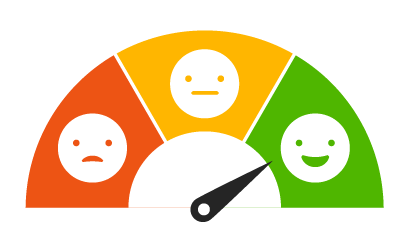Why Customer Satisfaction Is Important: 3 Reasons and More You Should Know

You’d be hard pressed to find a viable company that isn’t interested in customer satisfaction. In essence, acquiring satisfied customers—and keeping customers happy—is the lifeblood of any successful business. Whether proponents of customer satisfaction surveys or Net Promoter Score (NPS), today’s most competitive companies spend significant amounts of time, energy and resources measuring customer satisfaction.
What is customer satisfaction?
In a nutshell, customer satisfaction (sometimes called CSAT) is the degree to which companies are meeting a customer’s expectations for a product or service. It’s the all-important precursor to customer loyalty, determining whether a customer is likely to make a repeat purchase and stay with a business long term. Often determined within the bounds of one transaction or interaction (online ordering, support call, delivery, etc.) or a set of interactions, customer satisfaction measurement—often a part of a larger brand marketing, research, quality improvement or customer experience program—can be applied to a wide variety of situations and industries.
Simple and understandable, customer satisfaction always relies on customer input and must be driven by consumer feedback. It’s best used when asking customers to evaluate a recent, specific interaction with a product or service.
While CSAT is relatively easy to obtain, there are some downsides. First, expectations of a product or service are not one-size-fits-all. A condition that meets one customer’s expectations could fall far short of another’s. In addition, as a single data point, satisfaction is a relatively low bar to hit—satisfied customers may still be competitively vulnerable. And dissatisfied customers are unhappy and much less likely to become loyal customers.
Methods for measuring customer satisfaction
The most direct way to determine if customers are satisfied with a product or service is to ask them as part of a targeted survey approach. However, there are several alternate ways to loosely measure customer satisfaction—and gather key customer feedback that can add value in meeting expectations and designing the products and experiences that customers want. A few common examples include social media monitoring, online reviews, chats and online community panels and forums. Some companies are even starting to use voice and text analytics to gauge levels of frustration and emotion or inflection in the voice, while others use written transcripts of calls.
While there are some drawbacks to unsolicited feedback, it’s a mistake to ignore it. In most cases, it’s free intelligence that’s available without companies having to put forth a lot of time and resources to gather it. It’s just important to remember that unsolicited feedback isn’t representative and is often generated by either really positive or really negative experiences.
3 key reasons customer satisfaction is important
When companies are consistent about measuring customer satisfaction, they are poised to reap several important benefits.
Avoiding customer churn. When considering basic touchpoints in the customer journey (examples: ordering, interactions with the call center or marketing, issue resolution or delivery), it’s unlikely that a single negative experience will drive the average customer to leave. This is particularly true in a business-to-business environment where fewer companies can meet specific customer needs. However, on the business-to-consumer side, competition is far greater, and customers can be fickle when expectations for a product/service are not met.
Customer churn is less likely when businesses are consistently measuring satisfaction at various key touchpoints in the journey. This allows companies to be agile at fixing issues along the way—before a significant breakdown in the experience occurs—and increasing the potential for retention.
Enabling better decision-making. Scrambling at the last minute to save a client relationship or protect the company’s brand usually comes at a high cost. This is often the case when a company’s customer satisfaction program focuses solely on Net Promoter Score surveys. Companies find out too late in the game—sometimes just weeks before contract renewal, when the NPS survey is deployed—that a company is unlikely to recommend. Now the race is on to try to identify and resolve issues that may have occurred weeks or months ago. When this happens, the company is forced to go to greater lengths to try and save the relationship by offering a discount on the renewal or devoting more account management time to retention. Gathering feedback more often from customers through transactional customer satisfaction surveys enables companies to make better decisions along the way to improve customer satisfaction, keep customers happy and hopefully achieve greater long-term loyalty.
Identifying areas for improvement. Obtaining consistent customer feedback and gauging satisfaction—especially when combined with key operational and organization metrics—helps companies pinpoint areas that may need improvement. As part of a robust customer experience program, customer satisfaction information makes identifying broken experiences in the customer journey easier and lays the groundwork for repeat purchases, word-of-mouth referrals and more loyal customers.
Customer satisfaction has its limits—here’s why
While we can’t overstate the importance of gathering key satisfaction data, companies must understand the limits of CSAT as a singular measure or form of customer feedback. In simplest terms, it’s knowing that while satisfaction is necessary, it’s not sufficient. Businesses do need to satisfy their customers, but there’s a lot more to it than meeting expectations at specific touchpoints. Other factors need to be considered:
- how well a product or service meets the customer’s individual needs
- how customer needs are always changing
- how well a brand fares when compared to competitors
Suppose a business is only looking at transactions or single interactions. In that case, it’s easy to overlook the global relationship a customer has with a company, product or service, which could have a much more significant impact on future intentions and behaviors.
Here’s an example: A customer has two positive interactions with a company and is fairly satisfied with the company’s product and services. A few weeks later, a competitor launches a product that’s better and cheaper. There’s a greater likelihood the customer may choose to purchase from the competitor. Satisfaction is important, but it’s not foolproof and as a sole measure won’t ensure retention.
When companies ask the right questions at a higher level, it’s possible to glean valuable feedback that reveals the overall health of the relationship and points to:
- Loyalty or future intention
- Overall attitudinal attachment to the relationship or the brand
It’s much less likely that a customer who rates a company highly in these areas will leave or take advantage of a different offer.
Beyond customer satisfaction: The value of gaining a wider view
While measuring customer satisfaction around specific touchpoints and interactions is important, companies must also find ways to evaluate and understand the totality of their relationship with customers. There’s an element of getting this kind of direct feedback on the total customer relationship that’s essential to sustaining long-term business success.
To gather robust insights of the total customer experience, companies should supplement customer satisfaction data with operational data and various forms of qualitative feedback. There is no shortage of these methods, which can include:
- Account team debriefs
- Advisory boards
- Focus groups
- Customer complaint systems
- Interactive voice response (IVR)
- Ethnographic research
- Journey mapping
- Online communities
- Online panels
- Qualitative interviews
- In-app feedback
- Kiosks
- Social media monitoring
- Chatbots
- Paper surveys
- Phone surveys
- SMS/text-based feedback
- Voice of the customer through the employee (VoCE)
- Web-based surveys and website feedback
With customer satisfaction as an element, devising a strong customer experience strategy that incorporates key operational metrics will help companies learn about the overall health of their customer relationships. A robust strategy serves as a springboard for companies to make better business decisions that improve the customer experience, which helps boost customer retention.
Turning satisfied customers into loyal ones
One of the biggest differences between satisfied customers and loyal customers is future intentions and behaviors. In other words, how attached they are to a company, product or service. Loyal customers intend to purchase from a company again and intend to refer.
The first step in transitioning satisfied customers into customers who are more likely to stay is to take a more 360-degree view of the customer experience.
- Think beyond interaction points to consider the end-to-end customer experience.
- Take a close look at the customer’s experience with the product and how it’s used, as well as the user’s experience with the brand.
- Be intentional about understanding your customers: who they are, what they need and how to best meet their needs.
- Work to provide a differentiated experience at key customer touchpoints.
- Choose selectively where and how to differentiate or “delight” customers based on what’s known about them.
Elevating customer satisfaction to a focus on improving the experience
The companies today that are most successful are the ones that deliver a total customer experience that’s designed with the customer’s needs—and satisfaction—in mind. To be “customer focused” and “customer aware” requires research, sound planning and a strategy with clear objectives for designing interactions and a total experience that sets a business apart from its competitors. Similar to brand promises, companies should strive to create customer experience promises that ensure customers walk away from every interaction with a set of distinct impressions: “we’re innovative,” “we add value,” “we’re easy to work with,” etc.
In the end, creating impactful customer experiences begins with acquiring and keeping satisfied customers. As the forerunner to customer loyalty, Net Promoter Score and customer experience, customer satisfaction has and likely always will be a mainstay in the quest to succeed in today’s most competitive business and consumer marketplaces.
Start a conversation with Walker Contact Us
